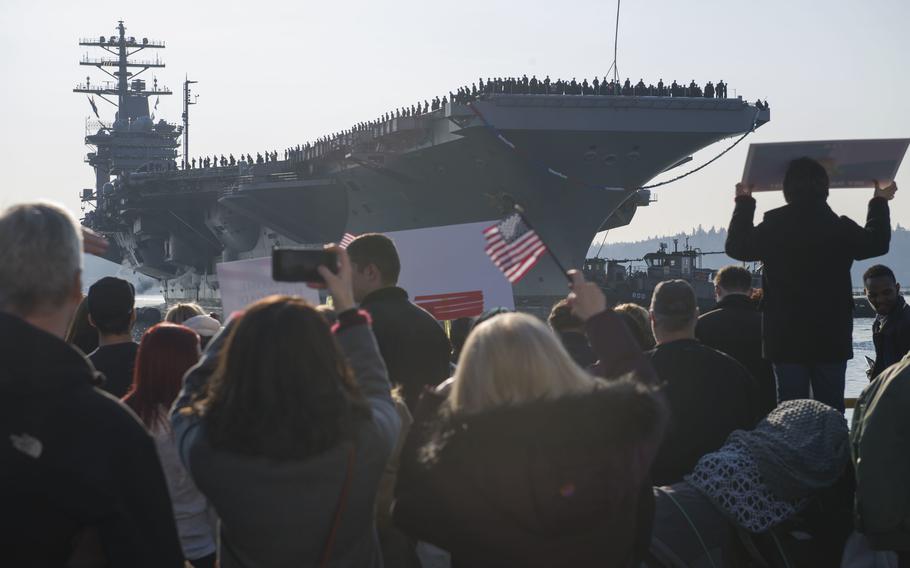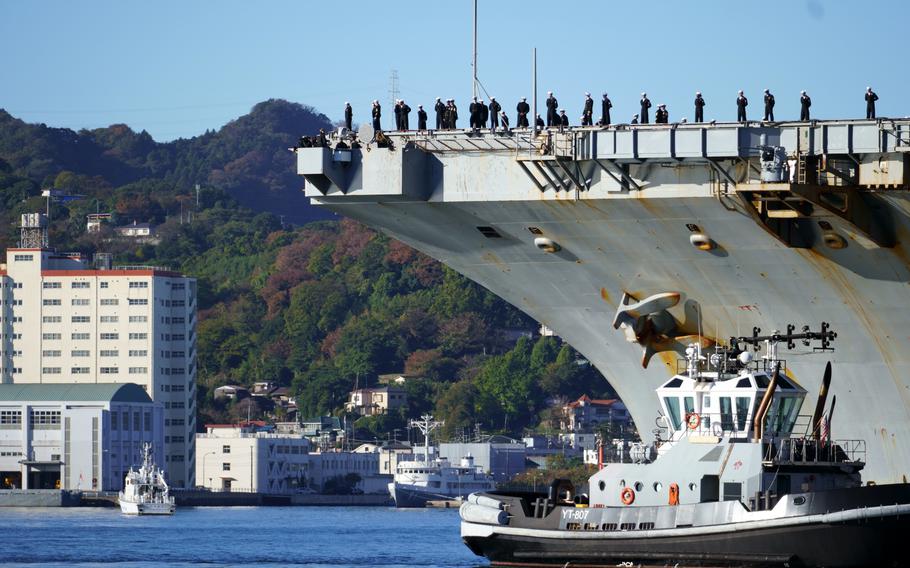
The aircraft carrier USS Nimitz pulls into port at Naval Base Kitsap, Wash., in December 2017. (Greg Hall/U.S. Navy)
Delays with the construction of new aircraft carriers and how to dispose of older nuclear-powered ships slated for retirement are fueling a housing crunch at Naval Base Kitsap, an expensive location at which to serve in the Navy.
The Kitsap commander has announced the public-private operator of base housing has been told not to renew leases for units occupied by retirees, reservists and others to make way for an influx of sailors expected in the summer.
“We certainly appreciate the inconvenience,” Capt. John Hale, commanding officer of NB Kitsap, said in a statement. “We’re focused on our support to the active-duty family members, those who the Navy has ordered here, and they need to find a place to live.”
Pressure on housing at the base is expected when the aircraft carrier USS Ronald Reagan arrives at Kitsap in the summer. It’s crossing the Pacific after nine years as the Navy’s forward-homeported carrier, based in Yokosuka, Japan.
The Reagan will go into Puget Sound Naval Shipyard at Kitsap for a two-year overhaul. It was to replace the USS Nimitz, which finished a six-month maintenance period last week at the Bremerton, Wash., base.
The Nimitz had been slated to move to Naval Base Norfolk in Virginia in 2025 to be decommissioned and eventually dismantled. The Nimitz is the Navy’s oldest active carrier, having been commissioned in 1975.
But the timeline for the Nimitz move has been pushed to 2026 at the earliest. In the meantime, the Nimitz will remain at Kitsap along with the Reagan.
“The Navy has problems with the delivery delays of new carriers and how to dispose of old carriers,” said Mark Cancian, a retired Marine colonel and now a senior adviser with the Center for Strategic and International Studies, a Washington, D.C., think tank.
The Nimitz was to be replaced in the fleet by the USS John F. Kennedy, the new Ford-class carrier being built at Newport News, Va.
However, delays caused by the coronavirus pandemic and new technology, such as electromagnetic systems to catapult aircraft off the deck, have put delivery behind schedule.
The Navy is also tackling how to dismantle the highly radioactive power plants in nuclear aircraft carriers. The USS Enterprise, the Navy’s first nuclear-power carrier, was deactivated in 2012 and decommissioned in 2017. But it still sits at Hill Shipyard in Newport News awaiting a final disposal plan.
The Pentagon has already solicited interest in subcontractors to work on the eventual dismantling of the Nimitz, but where and when the work will be done is still under discussion.
The impact for Kitsap is finding a way to accommodate the crews of two aircraft carriers while the base is undergoing renovations that have caused a shortage of offices and other facilities.
The sprawling 12,000-acre installation is the third-largest Navy base after Norfolk and San Diego in California. It’s home to a carrier strike group, attack and ballistic missile submarines, the naval shipyard, a fuel depot and 70 tenant commands.
Naval Base Kitsap has about 33,800 military and civilian personnel, including 10,000 uniformed active-duty service members, according to the Navy. Another 7,500 defense contractors work at the base. An estimated 18,700 military dependents and 35,000 retirees live in the area.
Nimitz-class carriers have a crew of about 5,200 at sea, but the aircraft squadrons move to nearby naval stations during their time in homeport, cutting the number of crew members who must be housed, fed and assigned.
“We had a crew of about 2,800 during maintenance,” said Lt. Cmdr. Tim Pietrack, the Nimitz’s public affairs officer.
In the past, the Navy solved the housing problems of ships in maintenance by requiring most crew to remain aboard in the shipyard.
However, studies have shown living inside the equivalent of an industrial factory leads to deteriorating mental and physical health of the crew and, in some cases, an increase in suicide attempts.
“Shipyards are notoriously bad for morale,” according to a 2019 Naval Institute report. “While some members of the crew are sent off for individual or team training, only a minor percentage of the crew is off ship at any given time. One thing is certain: The ship’s professional capabilities and capacities are in rapid and serious decline during shipyard availabilities.”

Sailors man the rails of the USS Ronald Reagan as the aircraft carrier returns to Yokosuka Naval Base, Japan, on Nov. 19, 2023. (Akifumi Ishikawa/Stars and Stripes)
Kitsap officials said last week that they are confident they can find housing for the Nimitz and Reagan crews.
“The crew and families will be accommodated through unaccompanied housing — barracks, on-base family housing and housing in the local community,” said Katharine Crabtree, spokeswoman for NB Kitsap.
In preparation for Reagan’s arrival, the base has sent notices to non-active-duty personnel living in base housing that their leases will not be renewed when their current ones run out.
The move was triggered by a Navy rule that non-active personnel can live in base housing if the percentage of active-duty personnel seeking housing is less than 95%. While Kitsap has experienced vacancies in recent months, the increase in personnel will cross the limit during the summer.
“As the demand from active duty starts to increase above 95%, they will have to start not renewing leases,” said Hale, the base commander.
The Ronald Reagan’s arrival will be the first time that two carriers shared the naval base since 2021-23 when the USS Theodore Roosevelt was in the shipyard dry dock for an overhaul.
The move order would affect up to 15% of non-active-duty families living in base housing, and 2.5% of all homes. To date, about 40 families have received the notices.
The Navy is following Washington state law and giving tenants at least 60 days’ notice that they must move out.
“No evictions,” Hale said. “Leases are ending.”
He said the base’s Navy Family Housing Office is assisting with relocations.
The move means more personnel will have to live off base, where the cost of living is above the national average.
Apartments.com, a major online housing monitor, reported for June that there were 486 apartments available in Bremerton, with an average rent of $1,575 for a one-bedroom, $1,741 for a two-bedroom and $2,008 for a three-bedroom.
The rents are about 2% lower than the national average, though they are higher than the East Coast naval base for carrier overhauls at Norfolk. The average rent for a three-bedroom apartment in the Norfolk area is $1,706 monthly — about 18% below the national average.
Rep. Marilyn Strickland, D-Wash., a member of the House Armed Services Committee, has cited the high cost of living for soldiers and sailors who must live off base in the Puget Sound area as a reason for proposing a $1.2 billion increase in the Basic Housing Allowance targeting enlisted personnel.
“Service members are being priced out of options to live near their bases, putting strain on our military families,” Strickland said in late May.
The plan is up for debate in Congress now as part of the fiscal 2025 National Defense Authorization Act, which sets policies and recommends expenditures for the Defense Department.
Cancian said the space crunch at West Coast naval stations is likely to continue.
“The shift in focus to the Indo-Pacific is going to mean more ships in more homeports on the West Coast,” he said. “Even if the problems with production of the Ford class and dismantling of the Enterprise are solved, the long-term reality is we will see more ships in the Pacific.”